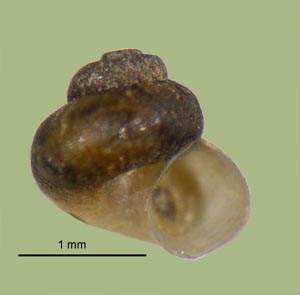> Habitat & Distribution
Lyogyrus latus is widespread in the main stem and some of the larger tributaries of the Ogeechee River in East Georgia. The FLMNH also contains single records of the species from the Altamaha River, and from a tributary of the Flint River in western Georgia, to which we have recently added an observation from the Broad River of South Carolina, all of which combine to imply that the range of L. latus may ultimately be found to include most of the larger rivers of the southern coastal plain. Thompson & Hershler (1991) described its microhabitat as cryptic, "only on the underside of chert and sandstone cobbles and boulders in riffles." But our net samples suggest that L. latus may also be common in the quieter reaches of the Ogeechee, in fine silt and (occasionally) on macrophytes. Lyogyrus latus demonstrates non-apparent rarity in our 17-state study region, FWGNA incidence rank I-3*.
> Ecology & Life History
In their original description of L. latus, Thompson & Hershler characterized its behavior as "secretive," possibly nocturnal. No specific life history data are presently available for L. latus, but Jokinen (1983) reported an annual life cycle for a population of Lyogyrus granum in Connecticut.
> Taxonomy & Systematics
Lyogyrus is a member of the hydrobioid family Amnicolidae, characterized by a doubly-ducted penial morphology (Hershler & Thompson 1988). Of the two amnicolid genera inhabiting the study area, Lyogyrus is distinguished by an operculum that is initially multispiral, becoming paucispiral in adult individuals.
Through most of the 20th century, Lyogyrus (Gill 1863) was treated as a subgenus of Amnicola, but Thompson & Hershler (1991) raised it back to full generic rank in their description of L. latus.
> Maps and Supplementary Resources
> Essays
- Earlier versions of this website, online until August of 2016, adopted the large, broadly-inclusive concept of the Hydrobiidae (sl) following Kabat & Hershler (1993). More recently the FWGNA project has shifted to the Wilke et al. (2013) classification system, distinguishing a much smaller Hydrobiidae (ss) and elevating many hydrobioid taxa previously ranked as subfamilies to the full family level. For more details, see The Classification of the Hydrobioids.
> References
Hershler, R.
& Thompson, F. G. (1988) Notes on morphology of Amnicola limosa
(Say), with comments on status of the subfamily Amnicolinae.
Malac. Rev. 21: 81-92.
Jokinen,
E. H. (1983) The freshwater snails of
Connecticut. State Dept of Environmental Protection Bulletin
109, 83 pp.
Kabat, A.R., and R.
Hershler (1993)
The prosobranch snail family Hydrobiidae (Gastropoda: Rissooidea):
review of classification and supraspecific taxa. Smithsonian
Contributions to Zoology 547:1-94.
Thompson, F. G. (1968)
The aquatic snails of the family Hydrobiidae of peninsular
Florida. University of Florida Press, Gainesville.
268
pp.
Thompson, F. G. &
R. Hershler (1991)
Two new hydrobiid snails (Amnicolinae) from Florida and Georgia, with a
discussion of the biogeography of freshwater gastropods of south
Georgia streams. Malac. Rev. 24:
55-72.
Thompson,
F.G. (2004) An identification manual for the
freshwater snails of Florida. 71.
Wilke T., Haase M., Hershler R.,
Liu H-P., Misof
B., Ponder W. (2013)
Pushing short DNA
fragments to the limit: Phylogenetic relationships of “hydrobioid”
gastropods
(Caenogastropoda: Rissooidea). Molecular
Phylogenetics and Evolution 66: 715 – 736.








